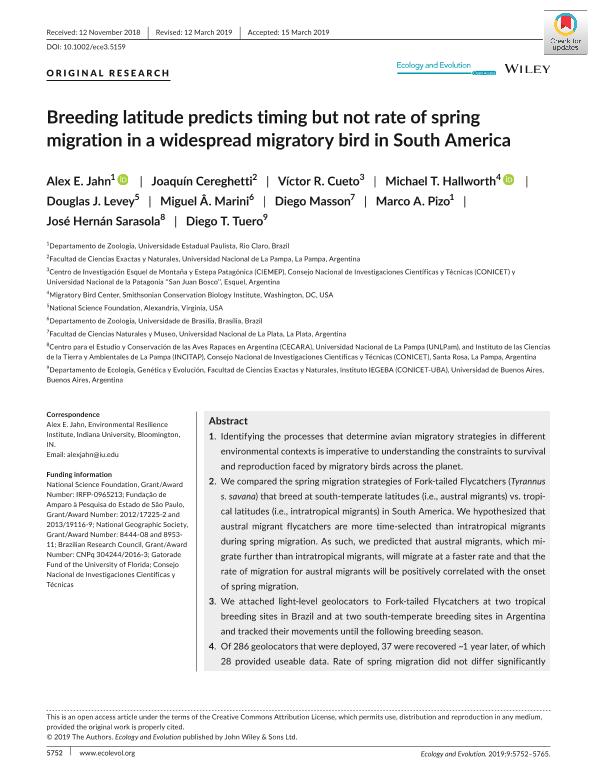Artículo
Breeding latitude predicts timing but not rate of spring migration in a widespread migratory bird in South America
Jahn, Alex; Cereghetti, Joaquín; Cueto, Víctor ; Hallworth, Michael T.; Levey, Douglas J.; Marini, Miguel Â.; Masson, Diego; Pizo, Marco A.; Sarasola, José Hernán
; Hallworth, Michael T.; Levey, Douglas J.; Marini, Miguel Â.; Masson, Diego; Pizo, Marco A.; Sarasola, José Hernán ; Tuero, Diego Tomas
; Tuero, Diego Tomas
 ; Hallworth, Michael T.; Levey, Douglas J.; Marini, Miguel Â.; Masson, Diego; Pizo, Marco A.; Sarasola, José Hernán
; Hallworth, Michael T.; Levey, Douglas J.; Marini, Miguel Â.; Masson, Diego; Pizo, Marco A.; Sarasola, José Hernán ; Tuero, Diego Tomas
; Tuero, Diego Tomas
Fecha de publicación:
04/2019
Editorial:
Wiley
Revista:
Ecology and Evolution
ISSN:
2045-7758
Idioma:
Inglés
Tipo de recurso:
Artículo publicado
Clasificación temática:
Resumen
Identifying the processes that determine avian migratory strategies in different environmental contexts is imperative to understanding the constraints to survival and reproduction faced by migratory birds across the planet. We compared the spring migration strategies of Fork‐tailed Flycatchers (Tyrannus s. savana) that breed at south‐temperate latitudes (i.e., austral migrants) vs. tropical latitudes (i.e., intratropical migrants) in South America. We hypothesized that austral migrant flycatchers are more time‐selected than intratropical migrants during spring migration. As such, we predicted that austral migrants, which migrate further than intratropical migrants, will migrate at a faster rate and that the rate of migration for austral migrants will be positively correlated with the onset of spring migration. We attached light‐level geolocators to Fork‐tailed Flycatchers at two tropical breeding sites in Brazil and at two south‐temperate breeding sites in Argentina and tracked their movements until the following breeding season. Of 286 geolocators that were deployed, 37 were recovered ~1 year later, of which 28 provided useable data. Rate of spring migration did not differ significantly between the two groups, and only at one site was there a significantly positive relationship between date of initiation of spring migration and arrival date. This represents the first comparison of individual migratory strategies among conspecific passerines breeding at tropical vs. temperate latitudes and suggests that austral migrant Fork‐tailed Flycatchers in South America are not more time‐selected on spring migration than intratropical migrant conspecifics. Low sample sizes could have diminished our power to detect differences (e.g., between sexes), such that further research into the mechanisms underpinning migratory strategies in this poorly understood system is necessary.
Palabras clave:
AVE
,
MIGRATION
,
NEOTROPIC
Archivos asociados
Licencia
Identificadores
Colecciones
Articulos(CIEMEP)
Articulos de CENTRO DE INVESTIGACION ESQUEL DE MONTAÑA Y ESTEPA PATAGONICA
Articulos de CENTRO DE INVESTIGACION ESQUEL DE MONTAÑA Y ESTEPA PATAGONICA
Articulos(IEGEBA)
Articulos de INSTITUTO DE ECOLOGIA, GENETICA Y EVOLUCION DE BS. AS
Articulos de INSTITUTO DE ECOLOGIA, GENETICA Y EVOLUCION DE BS. AS
Articulos(INCITAP)
Articulos de INST.D/CS D/L/TIERRA Y AMBIENTALES D/L/PAMPA
Articulos de INST.D/CS D/L/TIERRA Y AMBIENTALES D/L/PAMPA
Citación
Jahn, Alex; Cereghetti, Joaquín; Cueto, Víctor; Hallworth, Michael T.; Levey, Douglas J.; et al.; Breeding latitude predicts timing but not rate of spring migration in a widespread migratory bird in South America; Wiley; Ecology and Evolution; 9; 10; 4-2019; 5752-5765
Compartir
Altmétricas



